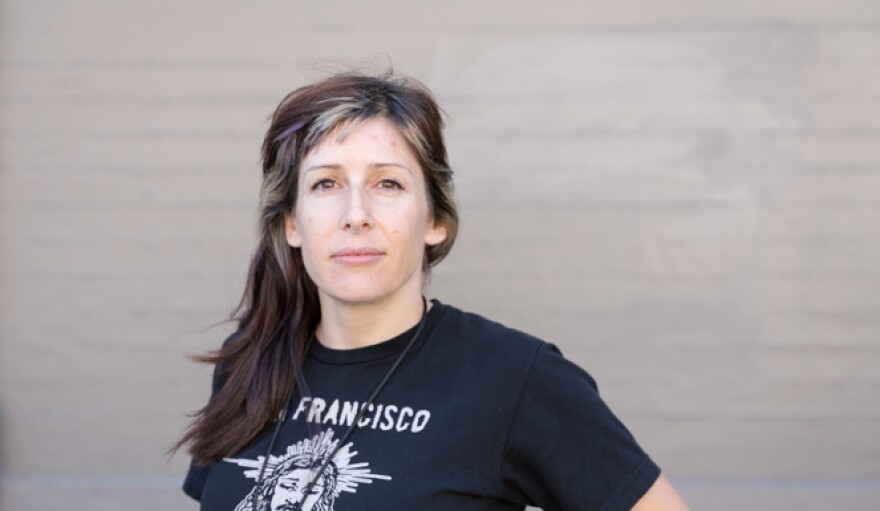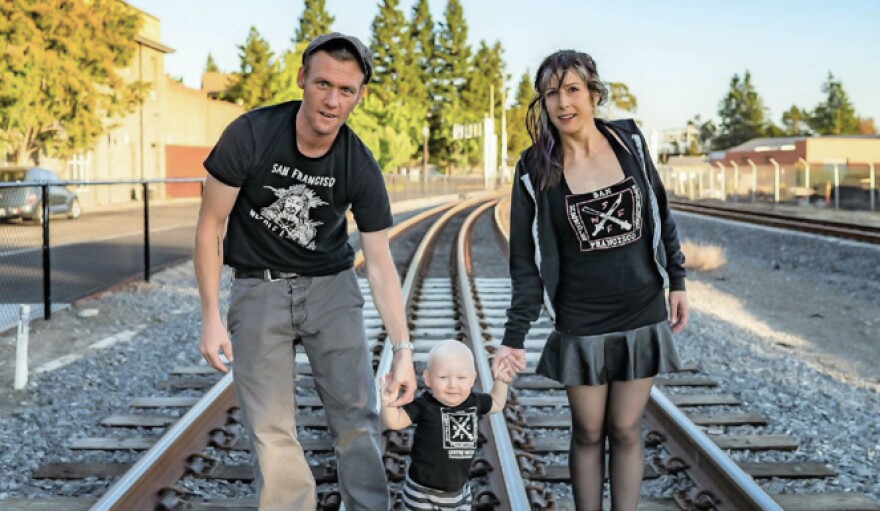In the Haight-Ashbury neighborhood, the San Francisco Police Department may be preventing injection drug users from getting clean needles. That could violate the department’s own guidelines — and have deadly consequences.
Since the Summer of Love in 1967, young people have arrived in the Haight, many seeking peace, acceptance, and the neighborhood's drug culture. Today, street kids still hang out on the sidewalks, often wearing flowing hippy dresses, dreadlocks, or punk Mowhawks.

"I understand, and I fully support, as chief of police, the reasons for the needle exchange." —SFPD Chief Bill Scott
Audra Meusx used to be one of those kids on the street.
"I'm 35 years old. I started using I.V. drugs when I was 18. I used for about 13 years of active addiction with heroin, crack, meth. I'm a multiple felon," she said. "I have two and a half years clean."
Meusx said she had a hard time fitting in in high school. She started using to cope. She also idolized writers and punk musicians, many known for their drug use. When she got onto the streets of San Francisco, "We had this little gang of roaming punk rockers and we all kind of looked out for each other."
Meusx also received some acceptance, some care — and some clean needles — from the people who work at the Homeless Youth Alliance.

"We get to know people on a really deep level," said Mary Howe, executive director of Homeless Youth Alliance. "Not everyone who comes is an injector or is accessing needles. Many people are accessing the staff for just support, or referrals, or other supplies. The focus, although it's called a syringe access site, is really about building relationships with people and getting their needs met."
"Most I.V. drug users know the needle exchange is essential. If we don't use the needle exchange, we contract diseases and we die. It's that frickin' simple." —Audra Meusx
San Francisco’s Department of Public Health supports the city’s syringe access programs. That’s because clean needles help cut down on the number of HIV and hepatitis C infections, two diseases that drug users often contract and can be passed along to others in the community.
Many syringe access programs provide basic healthcare, which reduces expensive ambulance calls and emergency room visits, too.
"The needle exchange is essential," said Meusx. "Most I.V. drug users know the needle exchange is essential. If we don't use the needle exchange, we contract diseases and we die. It's that frickin' simple."
Syringe access programs work, too. Since 2012, even as the opioid epidemic and injection drug use have surged, the number of injectors who contract HIV in San Francisco has remained about the same.
But that progress may be under threat by the actions of another branch of the city government: the San Francisco Police Department.
At the syringe access program in the Haight, foot patrol officers spend a lot of time near the needle program, which meets three nights at the Haight Ashbury Free Clinic.
If you’re picturing a gritty street scene, this isn’t that place. It’s in a nice neighborhood where most of the buildings are charming old Victorians.

If you walk by, you might notice someone sitting on the steps while holding a sign. On July 26th, that person was a volunteer named Hannah Horovitz. When I got there, she told me what she just saw.
"Two police officers were standing across the street, and they talked to a man who was sitting against the wall. They had him move on, and they stayed across the street."
The cops stayed there for about half an hour. They said they had issued a citation to the man for sitting on the sidewalk. And after those officers left, it wasn’t over.
"I think they're trying to intimidate the people who would otherwise be able to freely come into our exchange. And are trying to scare people." —Hannah Horovitz, Volunteer
"Ten minutes later, two different officers pulled up in an SFPD Jeep. They parked directly in front of the clinic," Horovitz said. The officers walked down the street and left their vehicle parked there for about 10 minutes.
Horovitz says the police presence is a problem. "I think they're trying to intimidate the people who would otherwise be able to freely come into our exchange. And are trying to scare people."
There are studies to back her up.
Research by Northeastern University Professor Leo Beletsky, among others, has found that when police search, arrest, or just conduct surveillance near a needle program, many people who use drugs will stay away. Other studies concluded that police encounters lead to increased risk of HIV and behaviors like sharing syringes.
But for cops, needle programs can be seen as easy fishing, meaning they’re a good place to find people to lock up: people on probation, on parole, with warrants or in possession of illegal drugs.
"I had a warrant most of the time," said Meusx. "So seeing a cop outside of the needle exchange was incredibly discouraging."
The San Francisco police department knows that their presence can be counterproductive. Back in January, they issued their latest bulletin about syringe access programs. It states that officers should use discretion and try not to interfere with the programs.
"What about the rest of the population that lives in the neighborhood? Our health and safety are just as important as the drug users’." —Lena Emmery, Neighbor
I wanted to find out what’s going on here. In May and June of this year, I spent 28 nights observing the foot patrol officers hanging out within eyeshot of the clinic.
The syringe access program met 14 of those nights. On half of those nights — seven total — there was a noticeable police presence.
And the 14 other nights, when the program didn’t meet? Zero. There wasn’t one time when the cops were there.
If you’re not a homeless drug user, a handful of foot patrol officers hanging out nearby may not sound like a big problem. But for Meusx, there is a significant impact.
"As a drug user trying to go and get a service, which first of all isn't easy to do, seeing the police outside of a needle exchange is an extreme deterrent," she said.

Yet some neighbors want the police there. Lena Emmery has lived in the neighborhood for 30 years. And she knows the intersection near the needle program.
"I don't go there because it's too scary. I mean I'll go to the post office, but only at 10 a.m. when I'm not subject to harassment and people trying to sell me dope."
About the public health benefits of needle programs, Emmery added, "Well you know, what about the rest of the population that lives in the neighborhood and has to put up with people that are delirious on drugs. Don't we get some protection too? Our health and safety are just as important as the drug users’."
"Most of us have the smallest spark inside of us that believes that one day there's a very, very, very slim possibility that we might get clean." —Audra Meusx
Bill Scott, San Francisco’s new police chief, says he’s working to strike a balance.
"I understand, and I fully support, as chief of police, the reasons for the needle exchange," he said. "However there is a larger public safety issue that we also need to be concerned about."
He mentioned sit-lie, a controversial ordinance that gives police a tool to physically move homeless people from sidewalks. "There are people calling us because they're concerned about sit-lie issues and things like that. And we have to be responsive to that part of the population as well."
The police department’s bulletin seems to imply that officers should steer clear of the needle program. I asked the chief: Why aren’t cops avoiding the area?
"I don't think it's a sound policy in any stretch of the imagination to say police officers can't be in any location because you might have an emergency that requires us to be there."
The chief’s stated support of syringe access programs is crucial at this moment because a task force the city brought together just recommend something new: safe injection sites.
If built, they would be places where medical professionals supervise people when they shoot up. They could become the first in the nation, building on San Francisco's tradition of supporting harm reduction efforts for people who use drugs, which goes back to the 1980s when the city became home to one of the first needle exchanges in the United States.
But just like the needle exchange in the Haight, those facilities could also become targets of policing that scares off people who use drugs.
"I think there needs to be community input," said the chief. "We have to hear from all sides. And then we have to decide on what's in the best interests of the whole."
With that input, Mayor Ed Lee and the Board of Supervisors can consider some changes. They could have the Police Commission issue an official policy around existing and future needle programs, which would be more authoritative than the current bulletin.
Similar to other cities, San Francisco’s policy could include clearly defined discretionary zones, places policed less aggressively during operating hours.

Professor Beletsky says that often officers are incentivized for locking people up. He suggests that departments instead could start to reward cops for helping out people who use drugs, like Audra Meusx.
"As hopeless as we are, I still believe that most of us have the smallest spark inside of us that believes that one day there's a very, very, very slim possibility that we might get clean and do something with our lives," Meusx said.
During her 13 years as a drug user, Meusx ended up using dirty needles. She contracted hepatitis C, which she now has under control.
But with different policies in place, Meusx may never have contracted hepatitis. She may have spent less time in-and-out of jail. And she might have gotten her life back together sooner.
Today, with two-and-a-half years clean, she’s healthy, strong, and looks great. "I am currently employed with two jobs instead of multiple felonies. And I have an 11-month-old son."
There are hundreds of thousands of people out there like Meusx. In San Francisco alone, there are more than 22,000 injection drug users, according to Department of Public Health estimates.
Getting the police and public health providers on the same page could determine just how long the country’s opioid epidemic will last.











